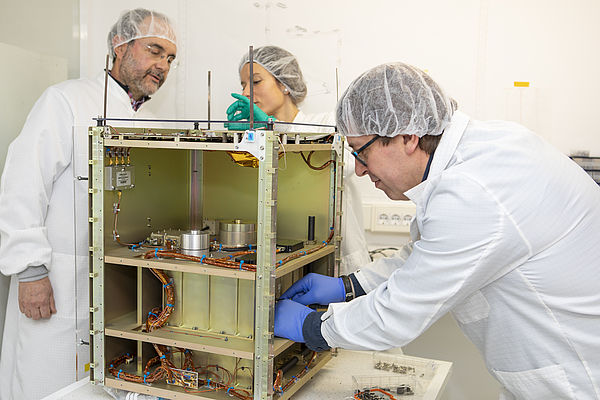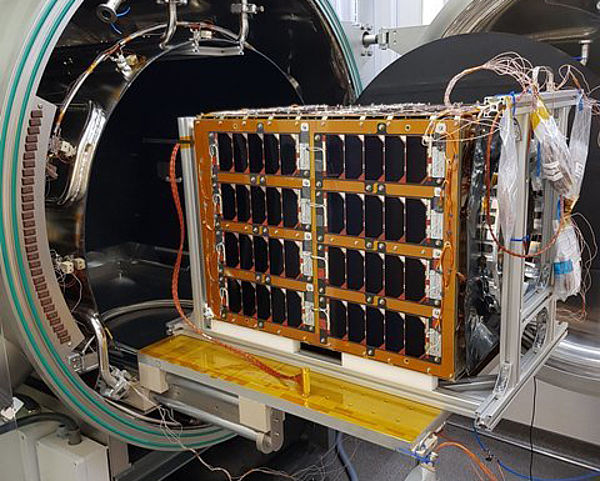UPMSat-2 has successfully completed the first of its objectives. The purpose of this project, led by the Microgravity University Institute “Ignacio Da Riva” (Instituto Universitario de Microgravedad “Ignacio Da Riva”) of the Universidad Politécnica de Madrid (IDR/UPM) and the research group Real-Time Systems and Architecture of Telematic Services (STRAST, Sistemas de Tiempo Real y Arquitectura de Servicios Telemáticos) of the Universidad Politécnica de Madrid, has been to design and build a small 50 kilogram satellite. The contribution in this project of students from the Undergraduate's Degree in Aerospace Engineering (GIA) and the Master’s Degree in Space Systems (MUSE), given at the School of Aeronautical and Space Engineering (Escuela Técnica Superior de Ingeniería Aeronáutica y del Espacio) has been crucial.
About 70 students have been involved in technical works which began seven years ago, thus "acquiring a direct experience, looking at a space system in all its aspects, getting involved in all phases, from the preliminary design (working in our concurrent engineering room) to integration and testing phases", explains Ángel Sanz, the Director of IDR. “We are proud of the work of the whole team, its members’ contribution and enthusiasm, which has allowed to overcome hurdles and complex situations arising during the satellite development, but this is the way of solving engineering issues," he adds.

Once completed the integration and testing phases and the “Fit to Fly” certificate issued, UPMSat-2 was presented during an event which Pedro Duque, acting Minister of Science, Innovation and Universities, took part in. The minister highlighted the work undertaken, which will allow in-orbit experiments of interest for the space industry, and the project educational value since many undergraduate, master and PhD students have been involved in its implementation. In this respect, Duque highlighted the relevance of the Spanish aerospace sector, which has a high training capacity and an industry that is a benchmark in satellite navigation systems.
The Rector of the UPM, Guillermo Cisneros, said UPMSat-2 is "an example of the projects starting at UPM aligned with the Sustainable Development Goals set out in the Charter of the United Nations for the 2030 Agenda. The experiments carried out in the satellite's payload will allow to progress in research regarding multiple cross-disciplinary fields, undertaken in an environment of partnership with industry and underlying the application of real engineering to improve the training of our students. We are proud to be a public university that has already built and will launch and operate its second satellite."

The second goal of UPMSat-2 is the in-orbit technological demonstration which is checking that in-house equipment works as foreseen. This can be the first step for companies of the aerospace industry to market their innovations, after being qualified in orbit. The experiments for the mission are: analysing the behaviour of a newly developed miniaturised thermal switch, proposed by IberEspacio; testing an experimental high-sensitivity magnetometer by Bartington; qualifying in-flight avionics (E-BOX), developed by Tecnobit; monitoring on board radiation effects, proposed by Tecnobit and STRAST; demonstration of the operation of a miniature reaction wheel for attitude control of the company SSBV; development of a new low-cost solar sensor; thermal and attitude control experiments based on the Earth's magnetic field, all of the latter are of interest to IDR.
During the presentation, the satellite launch date has been announced. On 9 September 2019, provided the weather conditions are favourable, UPMSat-2 will be launched into space in a VEGA from Kourou (French Guiana). In a service life estimated at three years, UPMSat-2 will orbit the Earth at a speed of 7 km/s, at an approximate altitude of 500 kilometres, it will complete 16 laps per day and will be passing overhead every 12 hours, always at the same solar time. Communications will be made from the Satellite Tracking Ground Station IDR has on the university campus in Montegancedo (Boadilla del Monte) and the ham community will have access to the satellite operating information.

Following the UPMSat-1 track
The Universidad Politécnica de Madrid already showed its capabilities to design, develop, build, test, integrate and operate a spacecraft with the UPMSat-1 project which was launched into space in 1995, with a service life of 213 days. UPMSat-1 was the fourteenth university mission and UPM is the tenth university institution worldwide to undertake a space adventure. In this event, the former IDR Director, José Meseguer, who died in 2015, was remembered that "he was the soul of this research centre and promoted the development of both satellites" as indicated by the current IDR Director, Ángel Sanz.
Following the UPMSat-1 track, and as a sample of the research potential of the Universidad Politécnica de Madrid, UPMSat-2 has been developed, with the unusual fact that some of the students who were involved in UPMSat-1 as students, nowadays have been working on UPMSat- 2 as researchers. This allowed them to see the project development from all perspectives, closing a cycle, and highlighting newly the educational and training component of this space technology platform.

